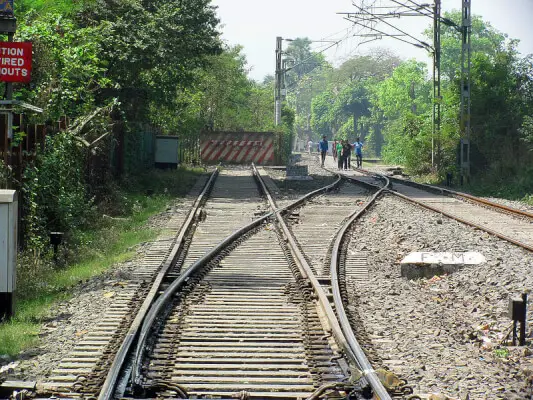Table of Contents
Branch lines have been a staple of railroads since people first began moving something from point A to point B by rail.
But what exactly are they? And are they still a thing in the modern era of railroading?
What are Branch Lines?
Branch lines are off-shoots of a primary railway line and are often used to connect smaller communities. This revolutionary addition helped smaller, deprived communities that do not have access to the main route reach the main railway station.
It creates an opportunity for the disadvantaged areas to enjoy the basic services offered by the railway, such as passenger and freight transport.
Alternatively, you can also have what is known as a rail spur, which is a really tiny branch line that is often used to let trains pass one another on a railway, which is pretty common especially in industrial rail.
The Function of Rail Spurs and branch lines
In order for a railway system to function properly, a synchronized organization of the main line and branch lines is super important. When the railway was the prime means for transportation, the quick establishment of branch lines was much in demand, especially for new and developing communities.
As these webs of branch lines spread, different varieties of them came about – a very small or short branch line is said to be a spur.
Branchlines were mainly established to connect towns and cities and also to monopolize the railway transport system back in the day.
Whereas a railway spur is predominantly used to allow other trains or locomotives to pass each other, or to allow for the unloading of people and goods without disrupting the main railway.
The Need for Branch lines
In America, the need for the branch lines arose in 1880 when the main railways or trunk lines across unpopulated areas needed to connect to populous Conception Bay. So, the first Blackman contract was drafted in 1881 that constructed a branch line to Harbor Grace.
Upon completion of the first-ever branch line in November 1884, the generous amount of profit that the connection began generating came to everyone’s notice. The operating profit caught the government’s eyes and seeing potential in the branch lines, the government bought it in 1896.
Economic prosperity flourished over the years since then. Halting the construction of the mainline, the government decided to build a 26-mile branch from Whitbourne to Placentia in October 1888.
During the late 17th century, an entire streetcar system for downtown St John’s could be built due to the easier railway transportation system made possible by the branch lines. Later the first hydro-electric development was also possible for it in 1898.
During the 18th century or 1900 onwards, the government utilized the branch lines in various ways starting with an establishment of a much-needed sawmill and later selling it off to private firms for faster and better development of the branch lines to help enhance business opportunities.
Reliable coastal boat terminals were established by 1921 and the branch was further upgraded in 1941 to serve the US navy.
Are Branch lines Still in Use
With the depleting need for the railway transportation system, thanks primarily to the trucking industry, the need for constructing new branch lines is slowly fading away.
But branch lines are still imprinted in the railways, and railway spurs are still especially prevalent in industrial railways!
The passengers are only being fair as these branch lines have now become less efficient with time since they couldn’t develop parallelly to the modern world. If someone wants to get back home after midnight, they are bound to take the subway system that runs all night whereas the branch lines usually close by midnight.
It’s pretty evident that the construction of branch lines has helped the development of vast communities – small towns converted to cities.
Apart from that, several railroads have also been improved, helping them establish their own network.
Though the extent of use may have declined, branch lines could be still resourceful especially to cover huge territories where there’s a lot of scope for numerous railway transport providers.
Bachmann Branchline Model Trains
Bachmann was founded by Henry Carlisle in 1833. The business started with producing walking cane handles, combs, and hair ornaments from ivory, horn, or tortoiseshell. After a few years in 1899, the company partnered with its competitor Henry G. Bachmann, and his son, Walter J. Bachmann, renaming the newly merged business Bachmann Bros.
The newly established business started using celluloid in their products to make celluloid optical frames in the 1900s. After a lot of experimentation, Bachmann Bros became the first-ever American company to make prescription sunglasses called “Solarex”!
Their business expanded and diversified after WWII. They began entering the model train field; upon gaining expertise in injection-moulded plastic, they started filling the model trains with “Plasticville U.S.A” which were simply the snap-together kits of various buildings.
The success finally trickled down to the model railroad area and started producing locomotives. The manufacturing company, Kader was again reapproached in 1969 to make the Bachmann Bros’ main manufacturing support for the production of model railroad products.
The lead manufacturing support of the Bachmann Bros., Kader Industries purchased the company in 1987 and renamed it Bachmann Branchline. It is a model train company that mainly is used for OO scale model trains for the British.
Though the parent company was US-owned, the Bachmann Branchline company was formed by Kader in Europe. The main headquarter of the model train company was established in the UK in 1989.
Peter has been building model trains for longer than he can remember. An avid fan of HO and O scale this blog is a creative outlet to allow him to dive further into other scales and aspects of the model train community and hobby.
